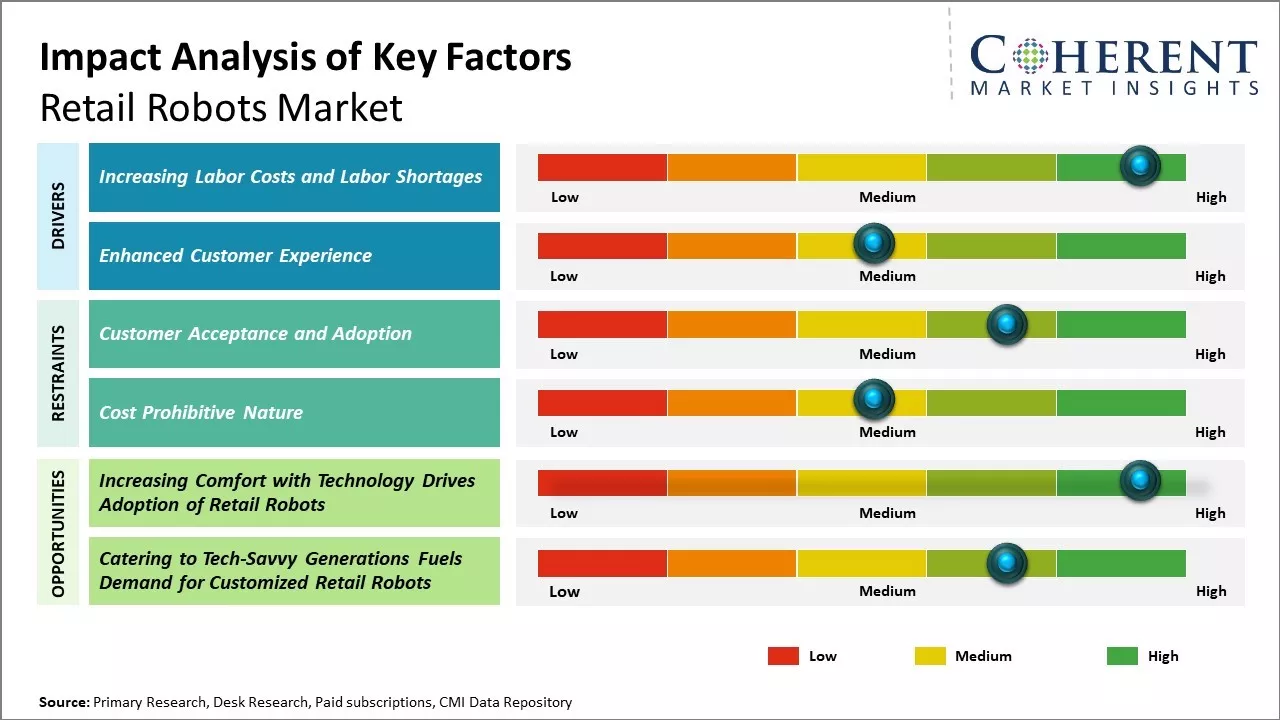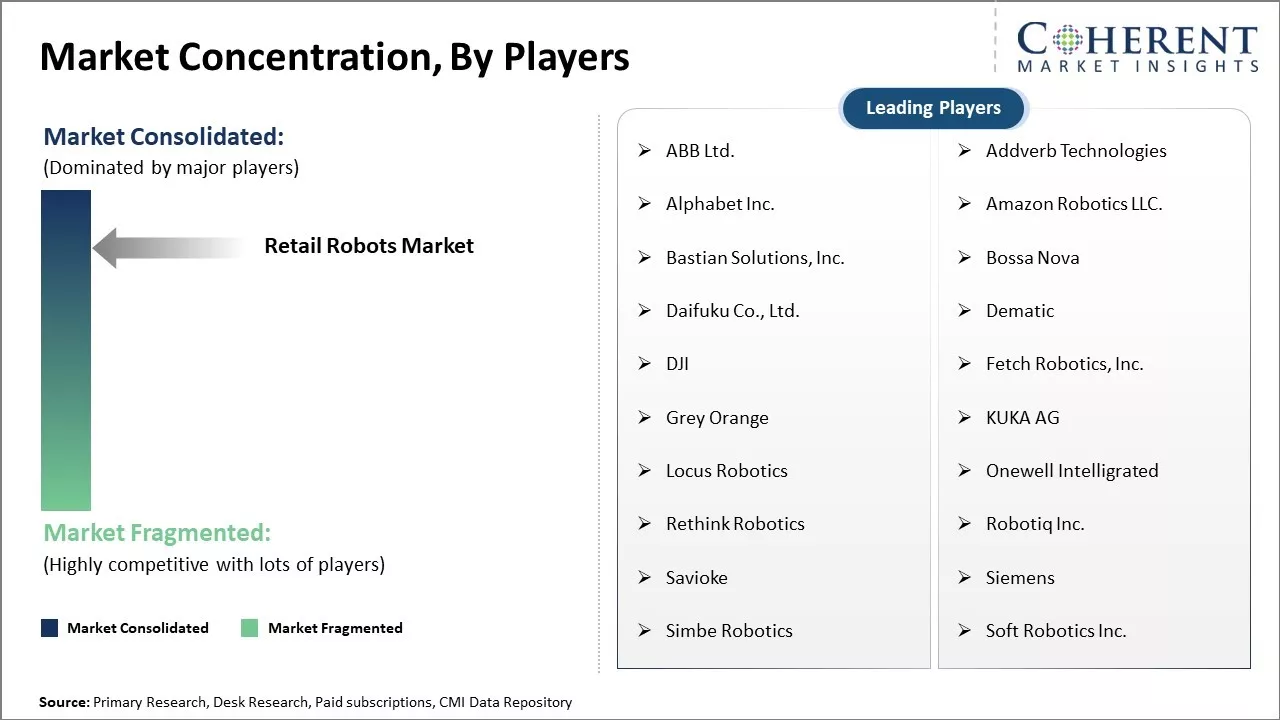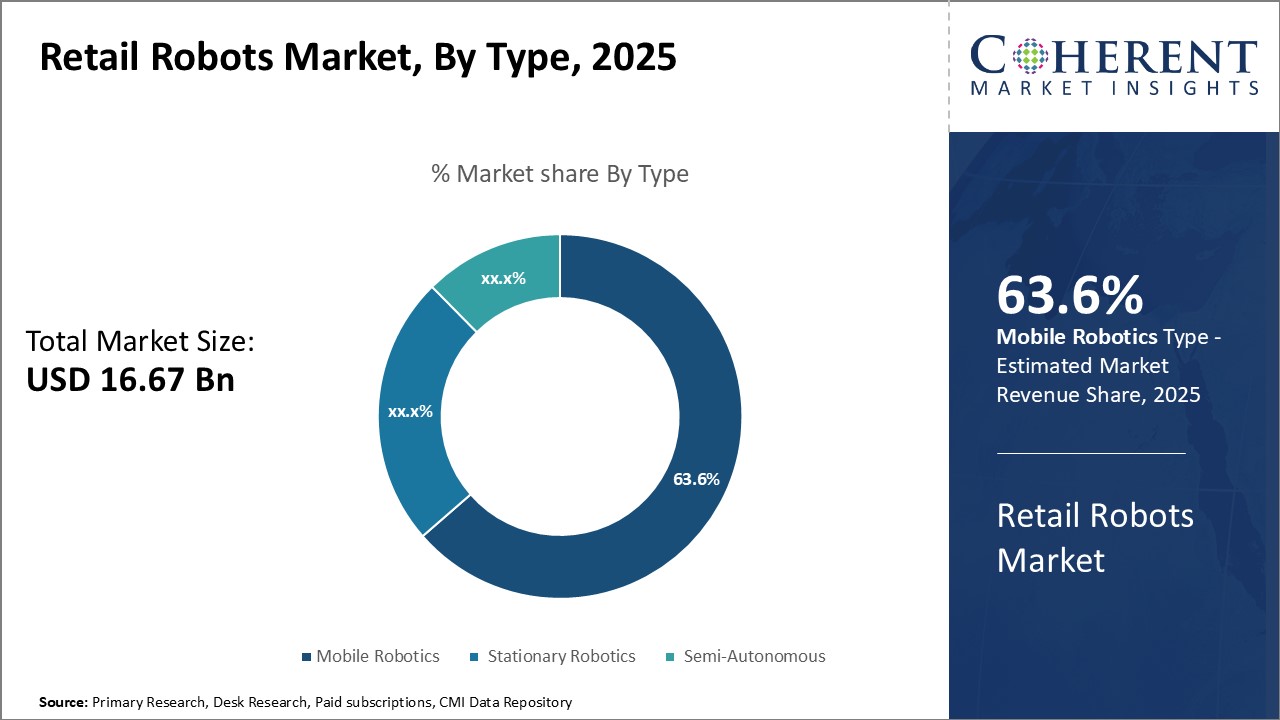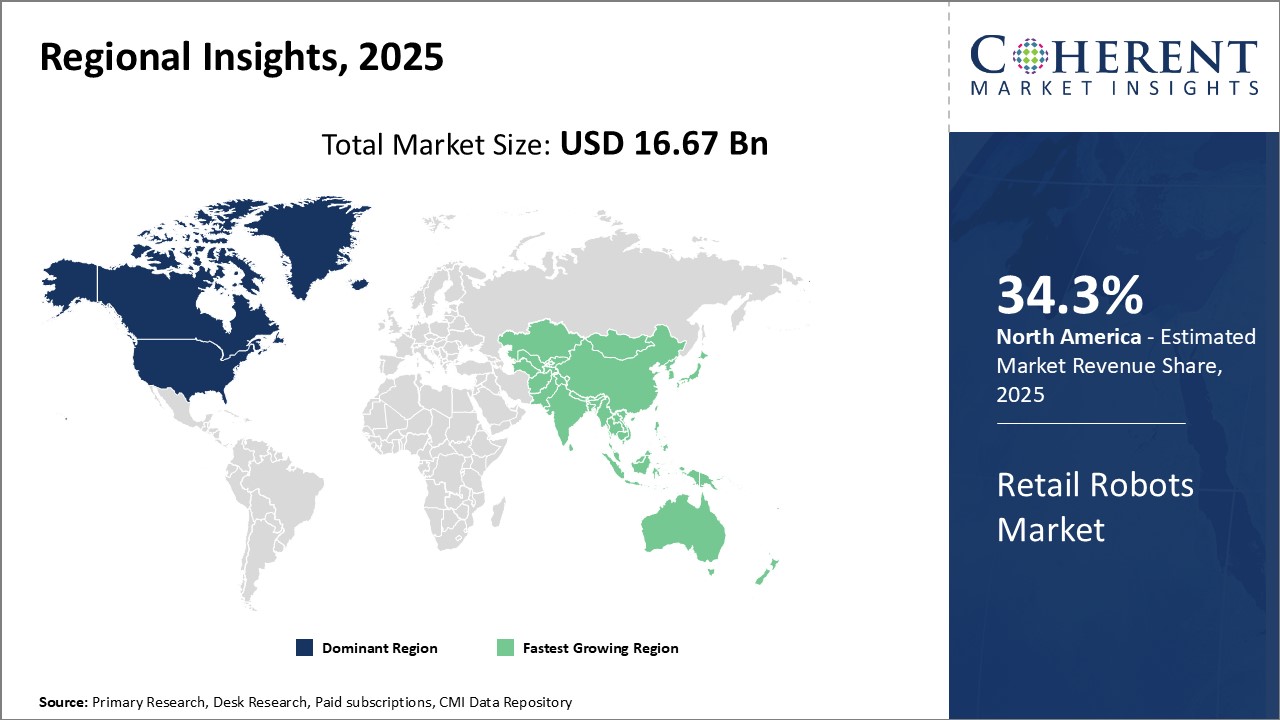Global retail robots market is estimated to be valued at US$ 16.67 Billion in 2025 and is expected to reach US$ 104.64 Billion by 2032, exhibiting a compound annual growth rate (CAGR) of 30.0% from 2025 to 2032.

Discover market dynamics shaping the industry: Request sample copy
Global retail robots market is expected to witness significant growth during the forecast period due to rising demand for automation and optimization of workflow in warehousing and inventory management. Retailers are focusing on implementing automated solutions to efficiently handle warehouse operations and streamline supply chain management. Furthermore, developments in AI, computer vision and IoT have enabled robots to perform complex tasks autonomously. There has been increase in adoption of collaborative robots that can work safely alongside humans. Advancements in mobile robot technology coupled with declining costs can facilitate their greater deployment in the retail industry. However, concerns around job losses due to increased robotics implementation can hamper market growth.
Increasing Labor Costs and Labor Shortages
Rising labor costs combined with labor shortages can boost adoption of retail robots by merchants and retailers across the globe. In many developed nations, there has been increase in costs associated with hiring and retaining human workers due to increasing minimum wages, healthcare benefits, and other employee-related expenses. With economies growing rapidly and unemployment rates declining sharply, it has become increasingly difficult for businesses to recruit and hire human labor at affordable rates. Furthermore, aspects like increasing employee attrition rates due to better career opportunities elsewhere have also disrupted business continuity for retailers.
To address these challenges, retailers are exploring ways to augment their workforce with robots and automated technologies that minimize dependency on human labor. While the initial investment required for deploying retail robots is high, merchants estimate that within 2-3 years the total cost of ownership for robots would be significantly lower as compared to employing humans. Robots do not require holidays, breaks or overtime pay like human workers and can work round the clock without breaks. Their cost remains fixed irrespective of dynamic market conditions unlike payroll costs which are directly linked to factors like wage inflation and minimum wage increases. Some retailers have reported labor cost savings as high as 30-40% after deploying robots for tasks like inventory monitoring, product replenishment and checkout. As robotics and automation further advances, the total cost of deployment is likely to reduce considerably, thus, strengthening the business case for workforce augmentation with robots.
In December 2022, Dobot introduced the Nova collaborative robots designed for retail automation. These new robots represent the first two Nova models, with payloads of 2 kg and 5 kg. These are specifically engineered for handling tasks in retail and physiotherapy, respectively.

Get actionable strategies to beat competition: Request sample copy
Enhanced Customer Experience
Another important driver for growing popularity of retail robots is their ability to deliver enhanced customer experiences as compared to traditional human-powered retailing models. Shoppers expect highly personalized, seamless and around-the-clock shopping experiences irrespective of their locations. However, providing such personalized one-to-one customer service at scale requires optimizing existing labor resources, which remains a challenge for many retailers. Thus, robots have emerged as a viable solution. Intelligent robots powered by computer vision, sensors and machine learning are being used by innovative retailers to gain richer customer insights, streamline operations and elevate shopping experiences. For example, robots equipped with cameras and advanced facial recognition can greet regular customers by their names, remember their past purchases and preferences, and provide customized recommendations and offers.
For instance, on March 22, 2024, Kuka, a Germany-based manufacturer, launched an arm that serves as the focal point of a store. This arm efficiently handles orders placed online by picking food items from a holding tray, placing them in an oven, and then passing them to its human coworker on the assembly line. This seamless process ensures smooth operations for Kernel, a store specializing in plant-based sandwiches and sides. Despite the robot's prominent role, Kernel's human workers remain content, contributing to the store's exceptional employee retention rate of 100%. Established by Chipotle founder Steve Ells with US$ 36 million funding, Kernel has been operational for about a month with only three staff members on-site at any given time.
Key Takeaways of Analyst:
Global retail robots market growth is driven by increasing demand for automation and labor cost reduction in the retail sector. Robotics technology allows retailers to enhance operations efficiency by automating inventory management and product replenishment tasks. This enables optimal product availability and improves the customer shopping experience. Grocery delivery robots and inventory scanners empower retailers to provide contactless shopping options amid the ongoing pandemic.
However, high upfront costs of retail robots and technological challenges related to navigation, object identification, and human interaction can hamper its widespread adoption. Smaller retailers may delay investments due to budget constraints. Major retail chains are likely to deploy robots aggressively to gain competitive edge and improve margins.
Innovations enabling collaborative robot operations and enhanced awareness about their long-term benefits can offer market growth opportunity. North America currently leads the market due to presence of global robotics players. Asia Pacific has growth potential with rapid retail infrastructure expansion in China and India. Retail automation is also accelerating in Western European nations to compensate for demographic challenges. With continued product improvements and cost reductions, retail robots are expected to play an increasingly vital role across global retail operations in the next five years.
Market Challenges: Customer Acceptance and Adoption
The customer acceptance and adoption of the technology can hamper the market growth. Many shoppers still prefer traditional in-person interactions with human sales associates. There are also concerns about robots disrupting jobs traditionally done by human workers. Retail robots need to gain customers' trust that these will not displace all human retail jobs. The upfront costs of purchasing, maintaining, and repairing robots can also be prohibitive for some retailers. Standardizing robot systems across different retail environments can also hamper the market growth.
Market Opportunities: Increasing Comfort with Technology Drives Adoption of Retail Robots
As retailers and shoppers become more accustomed to technology, there will be significant opportunities for growth of retail robotics market. Robots can efficiently handle repetitive and physically demanding tasks, allowing employees to redirect their focus towards more customer-facing roles. This trend is expected to boost adoption rates as businesses prioritize enhancing the overall customer experience.

Discover high revenue pocket segments and roadmap to it: Request sample copy
In terms of Type, Mobile robotics segment contributes the highest share due to versatility and cost-efficiency
By type, mobile robotics segment is estimated to account for the highest market share of 63.6% in 2025, owing to versatility and cost-efficiency associated with mobile robots. Unlike stationary robots that are confined to dedicated workstations, mobile robots can move autonomously throughout retail facilities to perform a variety of tasks. Their mobility enables them to multi-task and fill various needs across the store from inventory management to customer assistance. Mobile robots can transport goods between the stockroom and sales floor, scan shelves to identify out-of-stock products, navigate shoppers to requested items, and more. Their roaming functionality essentially transforms them into a flexible robotic workforce for retailers.
Mobile robots also provide a cost-effective solution as compared to stationary robots or human labor for certain roles. These do not require dedicated workstations or infrastructure setup like stationary robots. Retailers can deploy mobile robots anywhere in the store as needed to streamline processes. Since mobile robots can perform the duties of multiple employees across departments, retailers gain operational efficiencies and labor cost savings. Their mobility also allows for continuous operation around the clock without breaks, resulting in increased productivity and throughput.
Moreover, mobile robots have become more affordable in the recent years as technology has advanced. Leading robotics companies continue driving down prices through economies of scale and standardization. For cash-strapped retailers seeking to automate on a budget, mobile robots present a less costly alternative compared to stationary systems. As prices further decrease, there will be huge adoption of these robots across the retail sector. The combination of easy deployment, multiple use cases, and attractive price points has cemented mobile robots as the dominant type segment in the retail robots market.
In terms of Application, Inventory Management Segment Holds the Largest Share Due to Crucial Role in Operations
By application, inventory management segment is estimated to account for highest market share of 31.7% in 2025 as inventory management plays a crucial role in overall retail operations and business outcomes. Ensuring adequate stock levels and prompt replenishment is foundational to retailer success. Mobile robots excel at automating inventory-related tasks like shelf scanning, cycle counts, and restocking through their roaming movement capabilities. By automating these core duties, retailers gain real-time visibility into inventory levels, out-of-stock products, expiration dates, and more across all selling areas. This allows them to make smarter procurement decisions, optimize replenishment strategies, and avoid costly stockouts that can negatively impact the customer experience and sales volumes.
Compared to delivery management and in-store services, inventory management also involves more frequent and routine duties that are well-suited for robots. Delivery management and customer-facing roles require greater human discretion and judgment that robots have not fully mastered. However, inventory monitoring and stock labor primarily revolve around mundane, repetitive scanning and transporting functions that can be easily automated. Given its operational importance and prevalence of automatable subtasks, inventory management captures the highest value within the retail robots application sector. As autonomous technologies continue advancing, robots are likely to assume more complex roles, but inventory will remain their core specialized domain in the near future.

Need a Different Region or Segment? Customize now
North America dominates the global retail robots market with estimated market share of 34.3% in 2025. The strong presence of major robotics companies such as Amazon, Lowe's, Walmart in the U.S. has boosted the adoption of retail robots across stores. These companies are extensively investing in autonomous mobile robots for applications such as inventory management, stocking, and fulfillment. The support from the government in the form of tax incentives for companies automating their warehouses and distribution centers has encouraged wider implementation of robots. Several pilot projects are currently underway to test delivery robots that can navigate sidewalks and deliver packages to customers.
Asia Pacific region is expected to emerge as the fastest growing market for retail robots during the forecast period with a CAGR of 37.2% for the forecast period of 2025-2031. Countries like China, Japan, and South Korea have a large number of retail outlets and growing labor costs. This has prompted retailers to invest in automation solutions to optimize operations. China, in particular, is actively promoting the use of robots across sectors as part of its 'Made in China 2025' initiative. Several Chinese companies are engaged in developing low-cost robots for warehouse inventory tasks. Japanese retail majors are at the forefront of deploying humanoid robots capable of interacting with customers in physical stores. The region also has a thriving base of component suppliers and robotics startups catering to the domestic demand as well as international markets.
Europe is also witnessing steady demand for retail robots due to dynamic retail chains seeking to streamline operations and gain competitive advantage. Countries like the U.K. and Germany have a thriving base of robotics manufacturers focusing on collaborative robots. Meanwhile, increasing labor costs in Nordic nations have further incentivized supermarket chains to explore robotic shelf stocking solutions. However, import duties on components and finished robots remain higher as compared to other regions. Growing awareness about the capabilities and benefits of automation boosts adoption of robotics across diverse retail segments such as grocery, pharmacy and apparel.
Retail Robots Market Report Coverage
| Report Coverage | Details | ||
|---|---|---|---|
| Base Year: | 2024 | Market Size in 2025: | USD 16.67 Bn |
| Historical Data for: | 2020 To 2024 | Forecast Period: | 2025 To 2032 |
| Forecast Period 2025 to 2032 CAGR: | 30.0% | 2032 Value Projection: | USD 104.64 Bn |
| Geographies covered: |
|
||
| Segments covered: |
|
||
| Companies covered: |
ABB Ltd., Addverb Technologies, Alphabet Inc., Amazon Robotics LLC., Bastian Solutions, Inc., Bossa Nova, Daifuku Co., Ltd., Dematic, DJI, Fetch Robotics, Inc., Grey Orange, KUKA AG, Locus Robotics, Onewell Intelligrated, Rethink Robotics, Robotiq Inc., Savioke, Siemens, Simbe Robotics, Soft Robotics Inc. |
||
| Growth Drivers: |
|
||
| Restraints & Challenges: |
|
||
Uncover macros and micros vetted on 75+ parameters: Get instant access to report
*Definition: Retail Robots market involves robots and automated machines that assist staff and interact with customers in retail stores, shopping malls, and other commercial facilities. Retail robots perform tasks like inventory management, product loading and unloading, shelf restocking, checkout and payment processing, product suggestions and recommendations, security monitoring, and social engagement to provide information to customers. These aim to improve operations efficiency, customer service levels, and sales through enhanced automation of routine retail work and interactions.
Share
Share
About Author
Ramprasad Bhute is a Senior Research Consultant with over 6 years of experience in market research and business consulting. He manages consulting and market research projects centered on go-to-market strategy, opportunity analysis, competitive landscape, and market size estimation and forecasting. He also advises clients on identifying and targeting absolute opportunities to penetrate untapped markets.
Missing comfort of reading report in your local language? Find your preferred language :
Transform your Strategy with Exclusive Trending Reports :
Frequently Asked Questions
Joining thousands of companies around the world committed to making the Excellent Business Solutions.
View All Our Clients
US Reciprocal Tax Impact Analysis On Retail Robots Market
Stay updated on tariff changes with expert insights and timely information